This weekend, we saw the latest onscreen version of murders of Thomas and Martha Wayne in Batman V Superman: Dawn of Justice. Just weeks ago, on Fox's Gotham, viewers saw young Bruce Wayne confront Patrick "Matches" Malone, the man, he believed, had murdered his parents.
Obviously, the deaths of Thomas and Martha Wayne are a key part of the Batman mythos, but the details behind their deaths, as well as the identity of the killer, have evolved over time.
Many fans are familiar with the Joe Chill story already, as well as how TIm Burton's Batman (1989) changed the origin to have a young Joker be the shooter.
But there is much more to the story than you think.
In this feature, we'll be covering:
- the multiple variations of Joe Chill's fate
- the various members of the Chill family over the years
- the one time that Superboy tried to help young Bruce Wayne try to catch the killer
- which comic book writer is responsible for the idea that Bruce met a young Jim Gordon shortly after his parents' deaths
- the two previously scripted versions of when a young Joker murdered the Waynes before the 1989 movie
- the secret reason why Jack Napier killed the Waynes in 1989, as revealed in an unproduced script
- the version where Selina Kyle witnessed the murders...before Gotham did it
- And the many other suspects on Batman's list over his career, including a Superman villain.
Let's begin...
1939: The Original: The very first version of the origin was published as a prologue to 'The Batman Wars Against the Dirigible of Doom' (Detective Comics #33), written by Bill Finger.
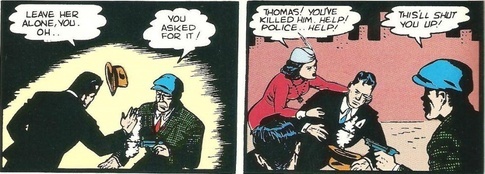
One fateful night, the Wayne family encounters a mugger, who demands Martha Wayne's necklace. Thomas resists and both of Bruce's parents are shot in front of Bruce, who is spared. Since the killer is never caught, Bruce makes a vow to avenge his family by fighting crime.
Adam West actually read the dialogue for Bruce Wayne from the original version of the origin in the PBS Superheroes: A Never-Ending Battle documentary:
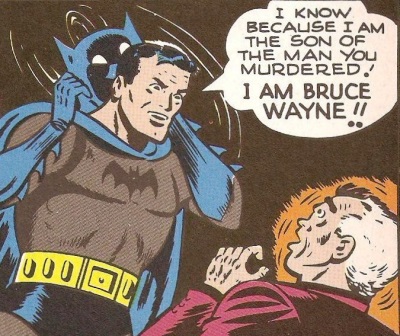
1948: The Killer was Joe Chill: Almost ten years after co-creating the character, Bill Finger returned to Batman's origin in 'The Origin of the Batman!' (Batman #47) and expanded on it further. Here, Thomas Wayne is shot, but in this account, Martha Wayne has a heart attack and dies. Afterwards, a young Bruce glares at Chill, with accusing eyes, prompting the murderer to flee.
The mugger is finally identified as a man named Joe Chill, whom Batman and Robin later encounter through coincidence years later.
Batman recognizes Chill and eventually confronts him, revealing his true identity as Bruce Wayne in order for Chill to realize that he created the Batman.
Chill foolishly confesses this to his cohorts. Enraged that he created their greatest enemy, the criminals turn on him and shoot him to death. Bruce declares the case to be closed...for now.
1956: Chill as Lew Moxon's Hitman: Bill Finger once again visits Batman's origin in 'The First Batman' (Detective Comics #235). Here, Chill, now named Joey Chill, is still the shooter, but this time, he's murdered by the mob before Batman could even get to him, retconning most of Batman #47.
Batman later finds out that Chill was actually working on the orders of mob boss Lew Moxon, who wanted revenge on Thomas Wayne for testifying against him after recruiting him from a costume party to operate on his wound. Young Bruce was left alive in order to testify that this was a random mugging and not a hit on the family.
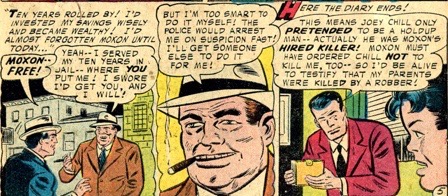
In the present day, Bruce’s costume gets destroyed in a fight with Moxon’s men, so he dresses up in his father’s bat costume to visit Moxon. The mobster sees him and believes that the ghost of Thomas Wayne has come back to haunt him.
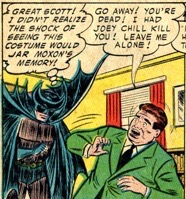
Terrified, he flees and runs straight into traffic, getting killed.
1968: Joe Chill's Brother, Max: In The Brave and the Bold #79, Batman works with Deadman- a former Haley Circus acrobat named Boston Brand who was killed and cursed to live his life as a ghost, only able to fight crime by taking over people's bodies.
In this tale, his number one suspect in his murder turns out to be Joe Chill's brother, Max, who also wants revenge on Batman for his role in Joe's death.
Ultimately, Max is innocent of killing Boston, but dies himself during a confrontation, when slot machines fall on him.
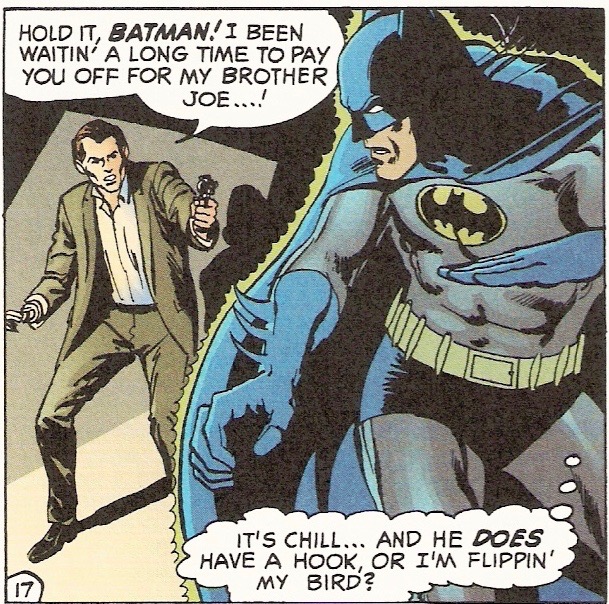
1969: Joe Chill's Mother: In Batman #208, Joe's real last name turns out to be Chilton.
In a cruel twist, Joe and Max's mother, Mrs. Chilton, is revealed to have been a caretaker of Bruce's after the death of his parents. (Note that in the original continuity, Alfred did not enter Bruce's life until well after he and Dick Grayson had become Batman and Robin, leaving a gap in who actually took care of Bruce Wayne when he was a boy).
While Mrs. Chilton is aware that her sons became criminals, she is ignorant of the role that Joe had on Bruce's life. Likewise, Bruce remains ignorant that Mrs. Chilton is the mother of the man who killed his parents.
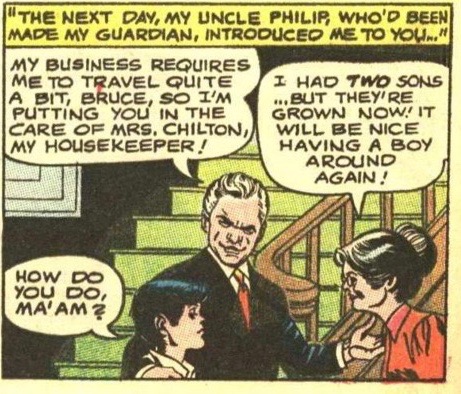
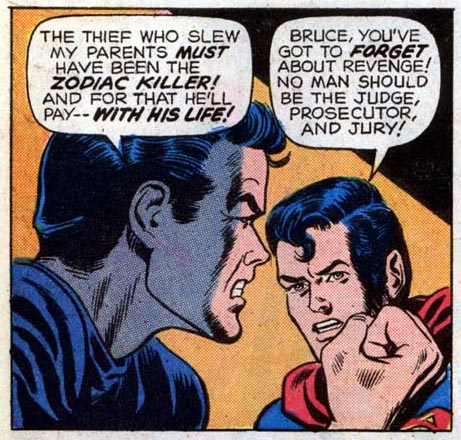 1972: Young Bruce Wayne hunts for the killer...as The Executioner. Co-Starring Superboy!: Earlier, it was established that young Bruce Wayne lived in Smallville with his parents for a brief period of time and took on the costumed persona of The Flying Fox to help Superboy fight crime (Adventure Comics #275, 1960). This was likely after Bruce had already received detective training from Harvey Harris while wearing the first Robin costume in Detective Comics #226 (1955).
1972: Young Bruce Wayne hunts for the killer...as The Executioner. Co-Starring Superboy!: Earlier, it was established that young Bruce Wayne lived in Smallville with his parents for a brief period of time and took on the costumed persona of The Flying Fox to help Superboy fight crime (Adventure Comics #275, 1960). This was likely after Bruce had already received detective training from Harvey Harris while wearing the first Robin costume in Detective Comics #226 (1955).
Thanks to a device that allowed him to look into the future, Superboy was able to see that Bruce would grow up to be Batman. When The Flying Fox figured out that Clark Kent was Superboy, he decided to allow Superboy to hypnotize him and wipe his memory, rather than risk betraying his secret.
Cut to Superboy #182 and Superboy would meet a very different Bruce Wayne. This teenaged Bruce Wayne had recently witnessed his parents' deaths. Upon revisiting the crime scene, Bruce overhears two cops talk about how the Waynes were killed under the sign of Saggitarius and that a serial killer named the Zodiac Killer is responsible (no relation to the real Zodiac).
Bruce, determined to get his revenge, goes out to track down the culprit and Superboy helps Bruce create a costume for himself (making this his third costumed persona as a boy, after Robin and The Flying Fox).
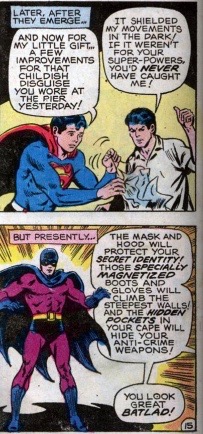
While Superboy nicknames him Batlad, Bruce calls himself the Executioner. Later, during the investigation, Superboy and the Executioner find out that the Zodiac Killer is actually a work of fiction that a reporter created to sell papers.
Disappointed, Bruce hangs up the cowl of the Executioner, not knowing that one day, he will don a much different costume, find Joe Chill, and help Clark in the war on crime.
1976: Crime Alley and Leslie Thompkins: Writer Dennis O’Neil revisits the origin in 'There's No Hope in Crime Alley!' (Detective Comics #457). Here, O'Neil reveals that the setting of the Wayne murder was a street called Park Row, later renamed Crime Alley.
It’s this version that implies that the murder occurred in a dark alley. Previous versions, however, did not specify this and made it look more like it happened in the middle of the street.
O'Neil also created the character of Dr. Leslie Thompkins, who was the first person to comfort Bruce at the crime scene and was revealed to be an elderly doctor in present day, who would receive visits from Batman every year without knowing the true reason why.
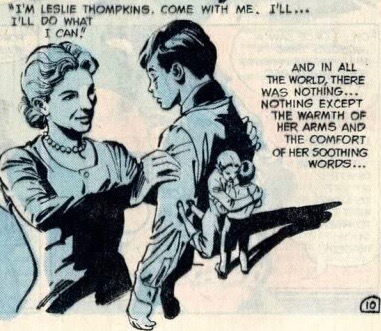
At this point, Joe Chill's story remained largely unchanged. But in the 1980s, filmmakers began developing a Batman movie and Chill's story would start to take a much different turn...
1982: Joe Chill as The Joker's Hitman: Warner Bros. starts developing the film that will become Batman (1989).
Screenwriter Tom Mankiewicz was one of the first screenwriters hired, after the success of his work on the Superman films. His first draft forThe Batman draws heavily from the original Bill Finger stories. Here, the Waynes are leaving the movie theater from watching The Nun's Story in 1960. Joe Chill still confronts the family and calls Thomas "Doc." Thomas asks how he knows who he is right before Chill kills him and his wife. Much like in Batman #47, Bruce glares at Chill, scaring him into running off.
Later, the script reveals that Chill was under the orders of the Joker, which is the first time in the movie's development that Joker's involved with the murder.
The Joker promptly kills Chill with Joker Venom to tie up loose ends and, in a later twist, the Joker reveals he arranged the hit on behalf of Rupert Thorne, Thomas Wayne's opponent in the race to be Mayor.
You can read this draft here.
1984: Joe Chill Dies from Seeing Batman: In Mankiewicz's next draft, the murder plays out the same but the Joker does not kill Chill afterwards.
Instead, years later, a rookie Batman tracks down an older Chill on his first night out and confronts him, revealing his identity. Chill recognizes who's under the mask and becomes frightened at the sight of Bruce coming back for revenge, prompting him to have a fatal heart attack. In a way, Batman gets his revenge on Chill in this version without directly murdering him.
You can read the second draft here.
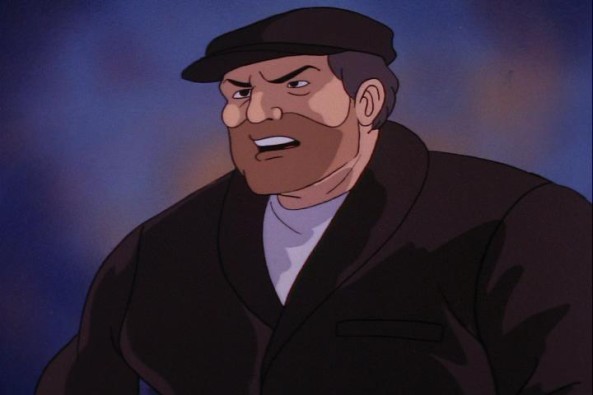 1985: The Waynes Die...in Animation: In the animated show The Super Powers Team: The Galactic Guardians, Batman, voiced by Adam West, encounters the Scarecrow, who makes him relive his fear of Crime Alley, where his parents were murdered.
1985: The Waynes Die...in Animation: In the animated show The Super Powers Team: The Galactic Guardians, Batman, voiced by Adam West, encounters the Scarecrow, who makes him relive his fear of Crime Alley, where his parents were murdered.
Batman later recounts his origin to Dick Grayson and Wonder Woman. In this version, the Waynes walked out of a showing of Robin Hood. When a storm was brewing, Thomas led his family down Crime Alley to take a short cut. Bruce was scared, but Thomas and Martha encouraged him to go with them. In that alley, they were confronted by a mugger, who demanded Martha's purse. Thomas objected and both parents were shot and killed in front of Bruce.
It's important to note that this was the first time that the Wayne murders had ever been adapted onscreen. The use of Robin Hood is also a precursor to the canon eventually settling on the movie being The Mark of Zorro, both classic films about outlawed heroes who fight corruption.
Like the Tom Mankiewicz script, it also explicitly showed Alfred taking care of young Bruce after the death of the Waynes, foreshadowing the change in comic book canon.
1985: Young Joker Kills The Waynes...from an Ice Cream Truck: Tim Burton co-writes a treatment with Julie Hickson in which the Waynes are walking back from a costume party, where Thomas is dressed as a bat, Martha is dressed as a fairy, and Bruce is dressed as a harlequin.
An ice cream truck drives by and a young Joker (already with green hair, pale skin, and red lips) opens fire on the couple and drives off, still playing music from the truck.
This is perhaps the least known and most surreal take on the murder. This is also the first time in years that Joe Chill is not the shooter.
You can read more about this treatment in our write-up and analysis:
http://www.batman-online.com/features/2010/7/25/analysis-of-the-1985-burton-hickson-treatment
1986: Gordon Investigates the Murders: WB recruits comic book writer Steve Englehart to write two treatments for the Batman film. In one of them, dated May 22, 1986, the Waynes are killed in 1974 in front of a 12 year old Bruce Wayne.
Bruce is later comforted by a 50 year old Inspector Gordon, who tells him and Alfred that they are still looking for the killer. While this may have been inspired by 1980's The Untold Legend of the Batman, which had a young Gordon meet Thomas Wayne when arresting Lew Moxon, this is the first instance of Bruce meeting Gordon right after the murders.
This idea would later be incorporated in Sam Hamm's first draft for Batman. Later, Wizard magazine would support the idea of Gordon investigating the Wayne murders in their concept for "Ultimate Batman." A mustached cop, heavily implied to be Gordon, would comfort Bruce in the episode 'Traction' from The Batman and Gordon would be there for young Bruce in live action for both Batman Begins and Gotham.
Samples of Englehart's treatment can be read on his website here.
1986: The Waynes Die After Watching Zorro: Frank Miller releases The Dark Knight Returns which is the first time that the Waynes are portrayed as walking out of Tyrone Power's The Mark of Zorro (1940).
The film also added the iconic imagery of the broken pearl necklace, which itself expands on the mugger’s request for Martha’s necklace in the original 1933 story.
The animated 2012 adaptation The Dark Knight Returns, Part 1 faithfully adapted this version:
1987: Batman Uses Joe Chill's Gun: Mike Barr writes Batman: Year Two. In this origin, Joe Chill actually left his gun behind after he killed the Waynes, by tossing it into the bushes. Young Bruce later found it and kept it in the Manor until years later, when he began using it in his war against a vigilante called the Reaper.
Ironically, in present day, Batman is forced to team up with hitman Joe Chill against the Reaper and eventually confronts Chill about the murder, putting a gun to his head.
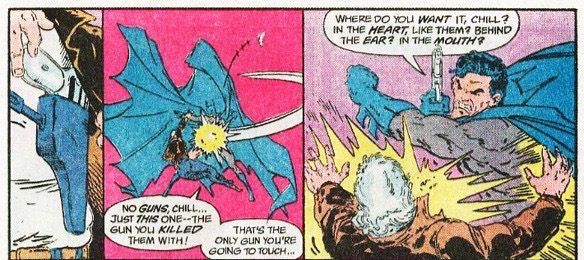
The Reaper, however, beats Batman to the kill by shooting Chill to death instead, robbing him of his revenge.
1989: Jack Napier Kills The Waynes: In the final film, Tim Burton has Jack Napier and another mugger (debated as either Bob the goon or, according to Michael Uslan in the intro for Batman in the Fifties, Joe Chill) stalk the Waynes after they walk out of the movie theater.
According to Uslan, Batman co-creator Bob Kane gave this change in origin his seal of approval:
It also seemed to make sense to have the young Jack/Joker as the killer of Bruce Wayne's parents in the flashback. Worried about that change in the legend, I asked Bob Kane for his thoughts on the matter. Bob replied that it made perfect sense and that, 'If the Joker had been created originally in 1939, that's who would have murdered the Waynes in the comic book!' As a tip of the hat to hardcore Bat-fans - and to Joe Chill - the scene in the movie showed Jack and another man responsible for the killing. It was hoped that would satisfy the majority of generations of Batmaniacs.
- Michael Uslan, Batman in the Fifties
While Sam Hamm wrote the original draft, it was Warren Skaaren who added the idea in the final draft of the film.
In this interpretation, it's implied that the Waynes walked out of a movie called Footlight Frenzy, indicated by the poster of the film outside the theater.
They are promptly followed by two criminals. One mugger (either Bob or Chill) grabs for Martha's pearls but the more dangerous one, Jack Napier, shoots both Waynes. He then steps out of the shadows, points a gun at Bruce, and asks Bruce "Have you ever danced with the devil by the pale moonlight?" before taking off.
Napier, years later, becomes the Joker.
Another change from canon is that the setting of the crime is not on Park Row nor Crime Alley (nor any kind of alley), but instead is in the middle of an abandoned street, like in the 1939 version, identified as the corner of Pearl and Phillips by Vicki Vale earlier in the film.
1990-1991: Jack Napier Was a Hitman: Sam Hamm writes a draft for Batman 2, which covers that the Waynes were part of the Five Families of Gotham (and Penguin sends a homicidal Catwoman to eliminate each of the members of the Five Families).
When talking to one of the members of the Five Families, Bruce learns that each family possessed a raven statue. When all five statues were brought together, it would reveal the location of the treasure that their ancestors stole. Thomas Wayne had refused to take part in trying to find the treasure after realizing it was part of a crime, so the other four families hired Jack Napier to kill Thomas and Martha Wayne.
You can read the full script here. While this is the only creative decision on record of explaining why Jack Napier targeted the Waynes in the 1989 film, it's important to note that this was not planned out in advance during the development of the previous film. Sam Hamm didn't write the twist that Napier was the killer, so his decision to tie Napier into the plot of his Batman 2 was entirely his retroactive addition.
1991: Joe Chill's Descendants: Mike Barr writes a sequel to Year Two, titled Full Circle, in which Joe Chill's son, Joseph Jr., is revealed to have witnessed his father's death, but mistakenly believed that Batman was behind his death and that the Reaper fought him. Inspired, Joseph takes on the Reaper's outfit and teams up with his sister, Marcia, to get revenge on an older Batman, who now has Dick Grayson/Robin by his side. He also takes the gun that killed the Waynes and uses it against Batman.
At the end, the Dynamic Duo discover that Joseph Jr. himself has a son, Joey (Joseph III).
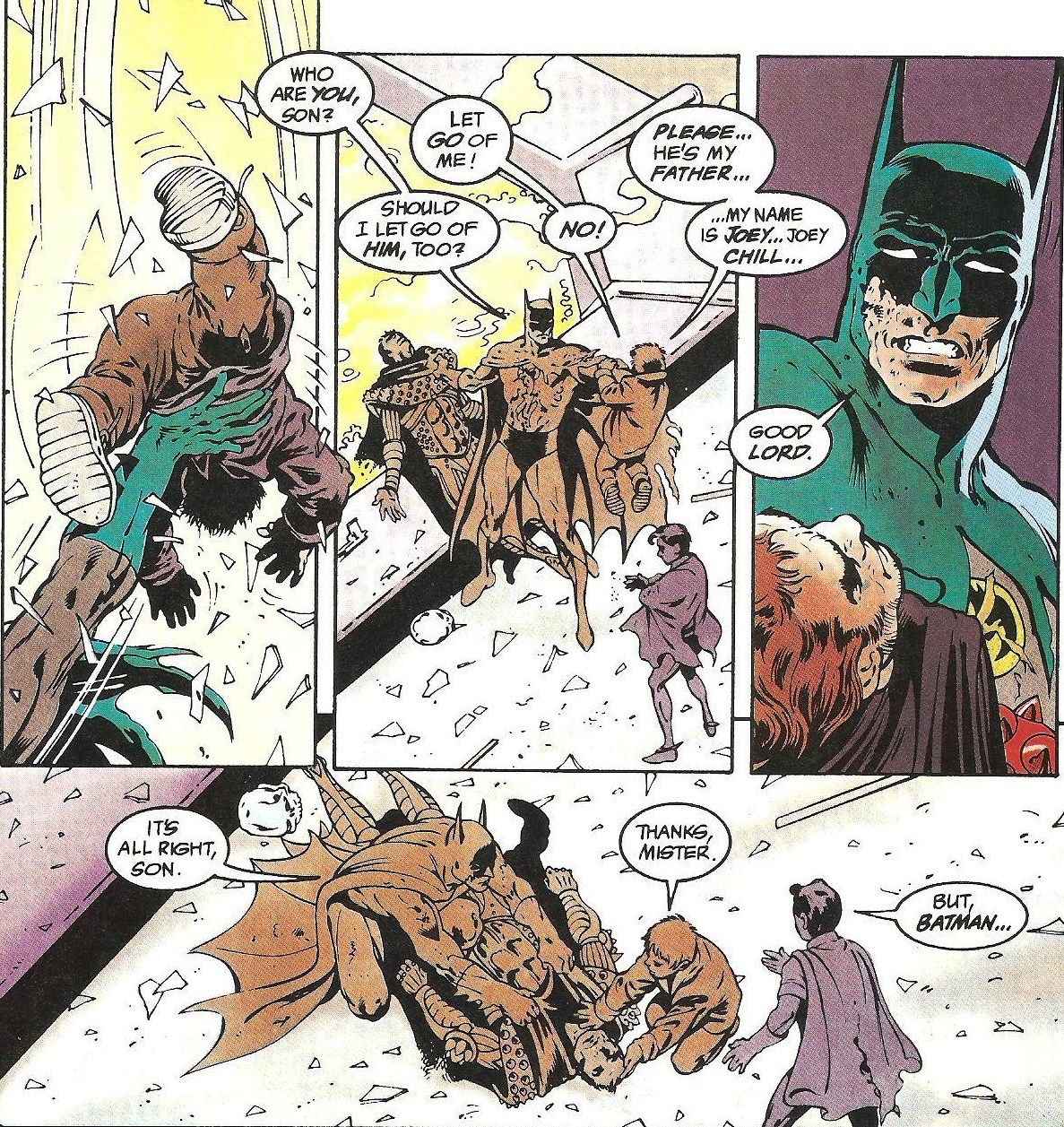
Joseph Jr./Reaper is arrested and Batman goes to a bridge with Robin and dumps the gun that killed his parents, effectively ending the cycle of violence.
In both the new continuity of comics and the new films, Batman had tracked down the man who killed his parents.
But the comics would soon take another twist with the story that would affect Bruce Wayne and his fans for years to come...
1994: Joe Chill Retconned: In one of comics' biggest changes, DC released Zero Hour, an event that affected all DC characters. In Detective Comics #678 by Chuck Dixon, Batman has the opportunity to visit the time around his parents' murder and visits Chill, only to find that he has been drugged and high this whole time, making it unlikely that he was the one to pull the trigger.
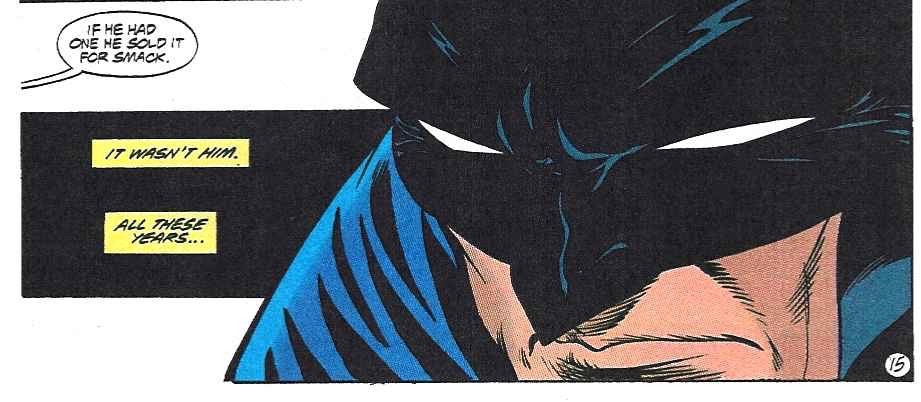 A month later, Doug Moench's Batman #0, then, revealed that the Waynes' killer was never identified and all previous Joe Chill stories were retconned.
A month later, Doug Moench's Batman #0, then, revealed that the Waynes' killer was never identified and all previous Joe Chill stories were retconned.

The "faceless killer" would represent all of crime's evil, to Bruce, and he would spend the rest of his life feeling the lack of closure over who murdered his mother and father.
Until this point, the Joe Chill story had been canon for 46 years. Now, the murder of Bruce's parents continued to be an unsolved mystery throughout his career.
1995: Bruce's Guilt: In a deleted subplot from Batman Forever, Bruce feels responsible for his parents' death because he was the one who insisted on seeing Zorro that night.
When he gets amnesia and finds his father's journal in the Batcave, he later discovers that it was actually his parents' choice to go and he only insisted on the choice of movie. He believes this absolves him of his guilt, but he decides to continue as Batman anyway.
If included in the final cut, this would have caused a debatable continuity issue since the 1989 film implied that the Waynes saw Footlight Frenzy while BF would outright say that it was a Zorro film. The Wayne murders were also reshot, with the addition of Martha Wayne carrying roses before she died.
1998: Selina Witnesses the Murder: In 1998, a Batman musical was announced from composer Jim Steinman, to be directed by Tim Burton.
In this version, Jack Napier/Joker is still the killer of the Waynes, but a young Selina Kyle is actually a witness to the crime and this influences her to grow up to become Catwoman. Steinman himself had this idea and wrote:
"... Selena Kyle, aka Catwoman secretly, was a WITNESS to the murder of Bruce Wayne's parents. A street urchin who happened to see it all, hidden away. The brutal murders haunt both Bruce and Selena. But both respond totally different to their traumatic bruising. Bruce learns to vow REVENGE and becomes the avenging knight, BATMAN. But Selena is mostly mentally scarred by realizing how easily things that are precious can be taken from you. (Mrs. Wayne's pearl necklace is ripped from her throat.) So Selena grows up, CRAVING precious jewels, & obsessed with HOLDING ONTO THEM! (She never wears them outside, shes a plain mousy woman, but she hoards them in chests.) Only when she transforms into CATWOMAN are her love of danger & lust for precious jewels & "crime" what dominates her. Its the secret total possession of them that drives her, not the public display.
So both "witnesses" to the crime of the Wayne's horrific murder by Joker has mutated two little "observers": Bruce became Batman, Selena became CATWOMAN. Two little "lost" children have mutated thru their own complex reactions to a numbing loss, and in fact fall in love, with a dark, somewhat "kinky" S&M like undertow. This is new to the Batman world.
http://mljs.evilnickname.org/jimsteinman/musicals/batmandemos.html
1999: Was The Wayne Board Behind It?: Years before Gotham, Tim McCanlies wrote the pilot for Bruce Wayne, centered around an 18 year old Bruce Wayne who returns to Gotham from his travels but spends years in his home city before donning the cape and cowl. In this pilot, the Waynes did see The Mark of Zorro beforehand and, like in the deleted subplot of Batman Forever, Bruce feels guilty over his insistence about seeing the film that night.
Through the story, Bruce finds himself in a rivalry with WayneCorp executive Charles Palantine and Alfred believes Palantine is trying to kill Bruce before his 18th birthday so that he can have the company to himself. In a dramatic scene, Alfred shares his suspicions that WayneCorp was behind the deaths of Thomas and Martha Wayne.
While the pilot was never produced, the concept of exploring a young Bruce Wayne, as well as suspecting the Wayne board of being behind the murder, would be fully realized in Fox's current show, Gotham, over a decade later.
For those interested in the script, you can read it here:
http://leethomson.myzen.co.uk/Pilot_Hell/Bruce_Wayne_1x01_-_Pilot.pdf
2001: Lew Moxon Reimagined: Lew Moxon gets brought back into continuity by writer Ed Brubaker in an arc beginning with Batman #591. This time, Moxon is the father of Bruce's childhood friend, Mallory. The backstory is still intact, with changes. According to Wikipedia:
Batman discovers that Thomas, Martha and (a very young) Bruce Wayne had attended a costume party (to which Dr. Wayne wore a Zorro costume) which was also attended by Moxon. At the party, Angelo Berretti, an 'employee' of Moxon's, told Dr. Wayne that a man's life was in danger. Dr. Wayne made Berretti promise his safe return before departing. Dr. Wayne was informed that Moxon's nephew required a bullet to be removed from his shoulder (following a failed armed robbery). Dr. Wayne performed the operation. Dr. Wayne refused to take any money, and started a fight with Moxon. Following this, Moxon had ordered the murder of Thomas Wayne. However, this was not carried out because of Berretti's promise.
Years later, Batman questions Angelo Berretti as to whether Moxon had been involved in the killing of the Waynes (which occurred a few months after the costume party). According to Berretti, Moxon was not involved. After Batman accepts Berretti's word and departs, Berretti holds his hand to his face and utters an ambiguous "Oh, thank God". Moxon's involvement in the killing of the Wayne is, therefore, left to the readers imagination.
https://en.wikipedia.org/wiki/Lew_Moxon
2003: Metallo as the Killer?: In Jeph Loeb's first story arc for Superman/Batman, Batman finds evidence that links the Wayne murders to criminal John Corben, aka the Superman villain Metallo, such as the fact that he was in Gotham during the time of his parents' death and that he used to carry the same kind of gun that killed them.
This evidence turns out to be faked by Lex Luthor as part of a trap for the Dark Knight Detective.
At this point, fans had gotten used to the idea that Joe Chill was out of continuity and the unknown killer of the Waynes would haunt Bruce for the rest of his life.
Both the comics and the movies would soon change history yet again...
2004: DCAU Batman Meets Chill...Without Realizing It: Ty Templeton wrote a version of the Joe Chill story for the DCAU called 'Fear Itself.' As summarized by Wikipedia:
Chill is shown to have spent his whole life as a career criminal since the night he murdered Bruce's parents. The story begins with Chill being released from prison after finishing a sentence for an unrelated crime, and it is apparent that he has been living in fear since that fateful night. Chill is convinced that Bruce Wayne, now one of the most powerful men on the planet, is biding his time to exact revenge. Chill's paranoia is so severe that he begins to see Bruce's face everywhere around him, even on other people. His paranoia goes into overdrive when he discovers that the retired detective who originally worked on the Wayne case has finally discovered evidence to reveal his guilt. Chill tracks the retired detective to his apartment and attempts to kill him, but Batman intervenes, unaware of who Chill is. In a brief scuffle Chill manages to unmask Batman, revealing the visage of Bruce Wayne.
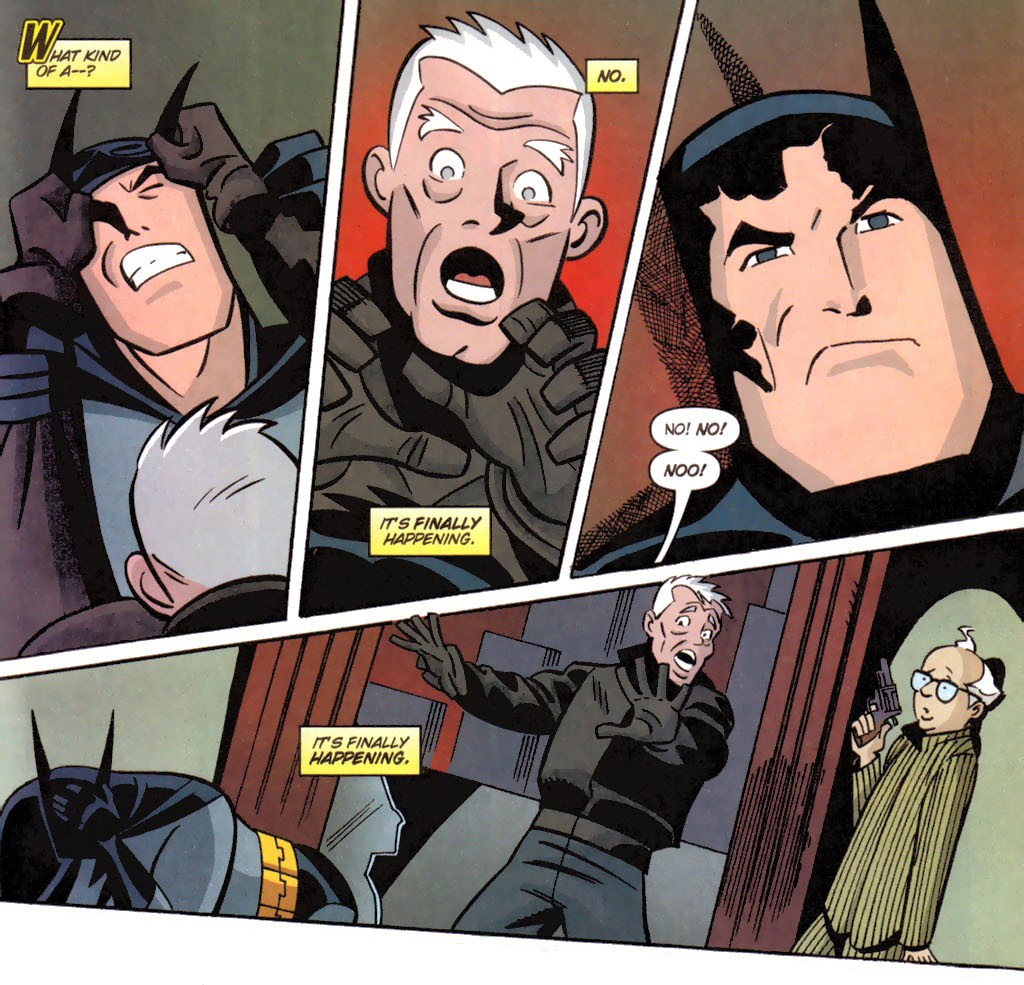
Terrified, Chill falls off a balcony, and Batman jumps after him in an attempt to save his life. Batman nearly catches Chill, who pushes him away and falls to his death. Batman is left at the end of the story wondering who the mysterious man was and why he would rather die than accept his help.
https://en.wikipedia.org/wiki/Joe_Chill
2005: The Opera and Joe Chill Got Caught: Batman Begins is released and creates, arguably, more changes to the murder than any other adaptation, as written by David Goyer and Christopher Nolan.
Here, the Waynes actually attend the opera house to see Mefistophele. Because the costumes remind Bruce of the bats that frightened him in the cave, Bruce asks Thomas if they can leave early.
Thomas agrees and they walk out through the side exit, which is probably the most organic explanation as to how the Waynes arrived in the alley.
Here, a nervous Joe Chill robs and kills Thomas and Martha Wayne.
Young Bruce is later comforted by a young Officer Gordon before he’s informed by Loeb that the GCPD actually caught Chill.
This is the first time in Batman history that the Waynes’ killer was caught on the actual night of the murder.
Years later, Chill attempts to get early parole by testifying against Carmine Falcone and Bruce arrives with a gun to try to kill Chill. Like in Year Two, he’s beaten to the kill by another assailant- Falcone’s assassin.
2006: Chill Gets Caught in the Comics Next: Infinite Crisis #6, by Geoff Johns, follows suit from Batman Begins and features a newspaper headline that says Chill was caught the same night of the murder, retconning Zero Hour's "forever unknown killer" after only 12 years of continuity.
2008: Batman has Chill Commit Suicide: Grant Morrison updates Batman #47 and Batman Year Two in a flashback/hallucination sequence.
In this version, Batman flashes back to his early days when he was dressed in his 1939 costume. His younger self continually haunts Chill over a long period of time. Chill admits that the reason he left young Bruce alive that night is because he reminded him of his late son and he couldn’t bring himself pull the trigger.
One night, Batman confronts Chill for the last time and makes him confess more about the murder of Thomas and Martha Wayne. Morrison merges Martha's heart attack from Batman #47 with the popular canon by saying that Martha Wayne could have survived her gun shot wound, but her weak heart led her to bleed to death.
Batman, like in Year Two, still has the gun that Chill used for the murder and returns it to him. In the moment, Chill figures out that young Bruce grew up to become Batman and that the rest of Gotham’s underworld will destroy him if they find out that he created their worst enemy. After Batman leaves him, Chill takes the gun and, in the next panel, Batman overhears a gun shot, implying that the man killed himself.
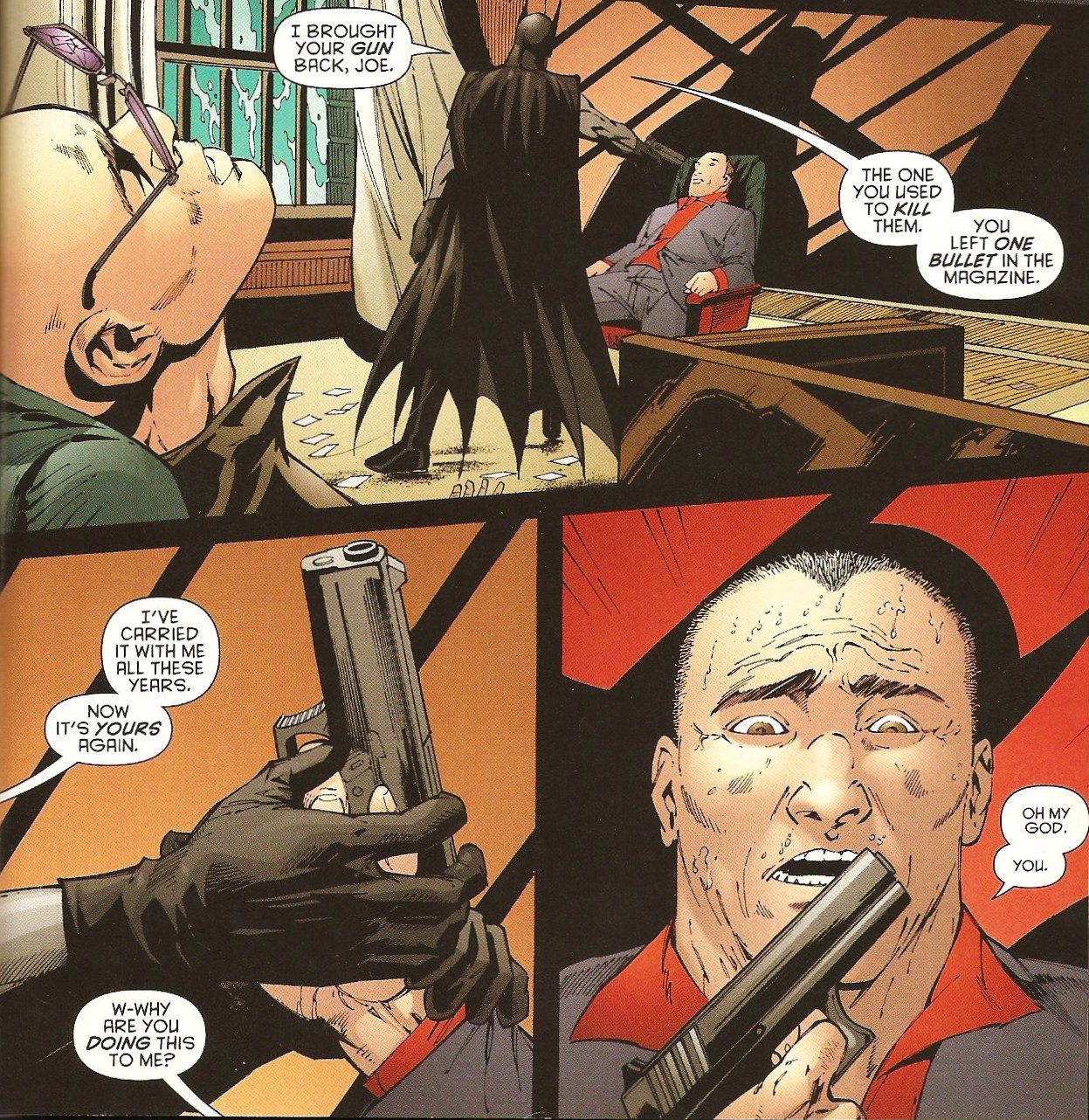
2010: The Spectre and the Phantom Stranger Intervene: In perhaps its most famous episode, the animated seires Batman: The Brave and the Bold tackled the death of Bruce's parents and the hunt for Joe Chill in "Chill of the Night" by Paul Dini.
This was a rather faithful adaptation to Batman #47 and Detective Comics #235, with various Batman alumni returning in the guest cast, including Adam West and Julie Newmar as Thomas and Martha Wayne, Richard Moll as Lew Moxon, Kevin Conroy as the Phantom Stranger, and Mark Hamill as the Spectre.
In this version, Batman had clearly been investigating his parents' murders for a long time and, in the disguise of a priest, goes to visit mobster Lew Moxon on his death bed. Moxon confesses to putting out a hit on Thomas Wayne and gives up the name "Chill."
Batman searches for Chill only to meet the Phantom Stranger, who takes him back in time to the night that Thomas and Martha attended a costume ball. Moxon and Chill crash the party and both Batman and Thomas stop them, but not before Chill gets away.
The Spectre then snatches up Batman and reveals that Chill, ashamed over abandoning Moxon, promised his imprisoned boss that he'll make things right and goes off to kill the Waynes. Batman locates Joe Chill at an arms deal, where he plans to sell weapons to most of Batman's Rogue's Gallery.
The Dark Knight crashes the meeting and confronts Chill, unmasking himself for the first time in the show:
Batman ultimately decides to let Chill live and lets him go. Much like Batman #47, however, Chill goes back to his cohorts and foolishly reports that he was the one who created Batman.
The Rogues Gallery gangs up on him, only for Batman to fight him off. As the building collapses, Chill gets crushed and dies. At the end, it's heavily implied that the Spectre caused the building to fall on Chill, fulfilling his role as the spirit of vengeance and punishing the killer after Batman proved that he couldn't do it himself.
2012: Did The Penguin Hire the Hit?: In Batman Earth One, Geoff Johns added another twist to the origin. Like the Mankiewicz script, he had Thomas Wayne run for Mayor around the time of his death. And like Batman Begins, Bruce had the family leave early from the theater.
In this version, a random electrical outage prevents the movie from even being shown. Young Bruce rushes out the back exit so he can get to another theater to see the movie.
There, he runs into a random man in a hoodie, who tells him to watch where he’s going. Bruce defies him and tells him that he’s the son of the richest people in Gotham. The man in the hoodie stops and identifies him as Thomas Wayne's son.
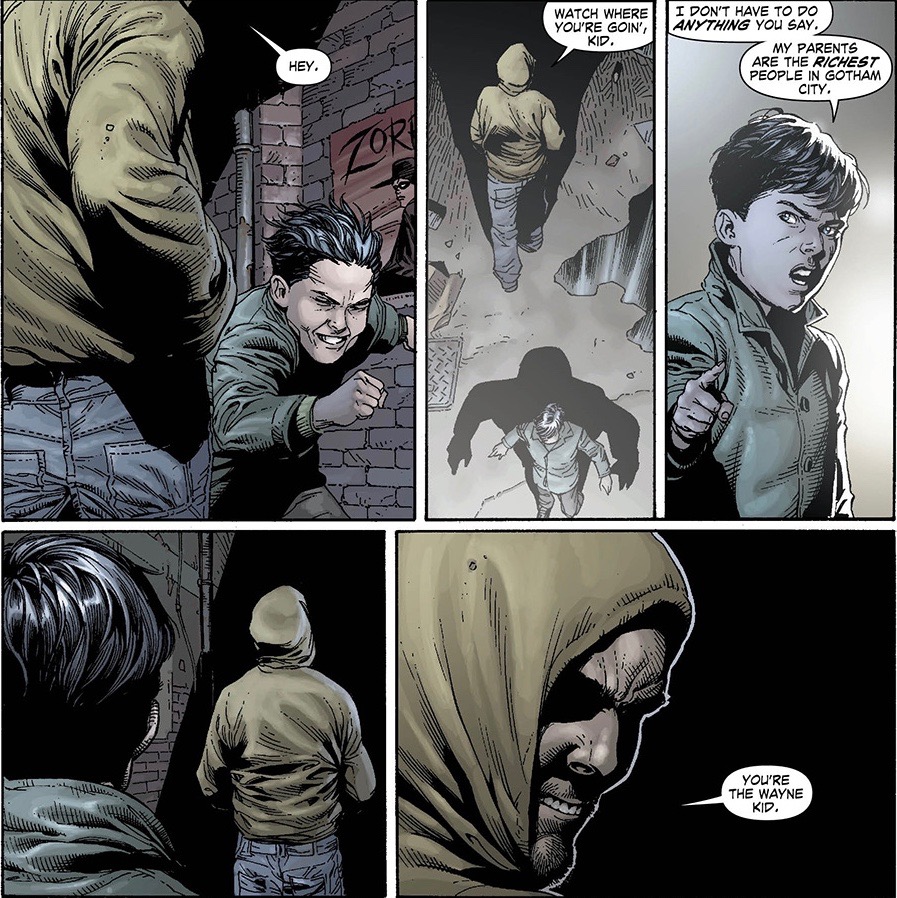
He then grabs Bruce, taking him hostage as Thomas and Martha come out of the theater. The man then demands their wallet, jewelry, and Martha’s pearl necklace before killing them both and escaping.
Years later, Bruce suspects that it was Thomas’s rival for the Mayor’s seat, Oswald Cobblepot, who ordered the hit. At the end, Cobblepot reveals that he wanted to kill the Waynes and had corrupt cop Jacob Weaver cut the power in the theater.
But since Bruce had his parents leave from a different exit, Cobblepot’s men couldn’t get to them and the real killer beat them to the punch.
The killer's identity has not been solved in the Earth One continuity.
But what about the main continuity? Or the new film/TV interpretations of Batman's origin?
2012: Not a Hit? Just a Mugging?: In the same year as Earth One, Gregg Hurwitz came up with a different interpretation for the New 52 version of Batman in The Dark Knight #0 that combined Batman #47 with Batman Begins.
Like the film, a young Bruce knows that Chill killed his parents and seeks to confront him with a gun. This time, though, Bruce actually confronts him and interrogates him on who sent him to carry out the hit. To his surprise, Chill tells him that he was acting on his own accord to get their money and he didn’t even know who the Waynes were until after he committed the crime.
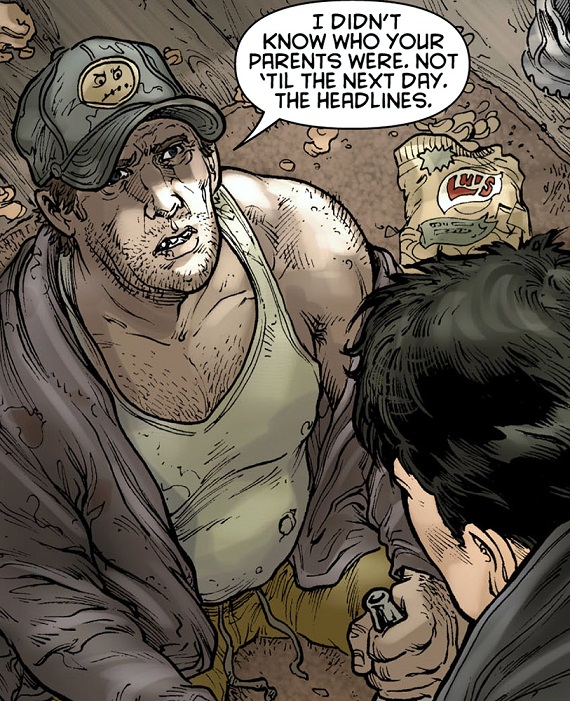
Bruce can’t believe that it wasn’t some kind of conspiracy. He’s tempted to pull the trigger, but decides that that’s not what his father would have wanted. He leaves and decides to undergo training to become a vigilante.
A later story reveals that Joe Chill got the gun from a man named Mallory Madison, the father of Bruce's future fiancee Julie Madison.
2015: The Bat-God Haunts Joe Chill: In a later encounter, in Justice League The Darkseid War: Batman #1, by Peter Tomasi, Batman develops powers from the Mobius Chair.
He visits Joe Chill in jail and takes him to Crime Alley. When Chill confesses his sins, Batman reveals his identity and tells him that he was the one who created Batman.
He eventually gets rid of Chill's memories of the incident and leaves him to rot in prison.

2014-2016: The Masked Killer & Matches Malone: In the show Gotham, the Waynes walk down an alley only to get robbed and killed.
This time, however, the mugger’s face is hidden and one can only see his eyes when he shoots Bruce’s parents. Also, like in the proposed Batman musical, Selina Kyle is a witness to the murder.
In this version, a young Jim Gordon and Harvey Bullock attempt to investigate the murder. Gordon meets Bruce and comforts him in the alley, promising him that he'll find the killer.
Their first suspect is Mario Pepper, father of the future Poison Ivy, Ivy Pepper.
Bullock shoots and kills Mario to save Gordon, but Gordon later finds out that Mario was set up by Carmine Falcone to give off the impression to the city that the police did their job. Falcone rationalizes that organized crime can't exist without law and order, otherwise, there'll be chaos.
Gordon tells Bruce the truth about Mario Pepper and promises to keep investigating.
Later in the season, a captured Selina Kyle tells Gordon that she knows the face of the killer, but later on, admits to Bruce Wayne that she lied in order to avoid going back to juvie.
Much like the Bruce Wayne pilot, Bruce suspects that the executives at his father's company were behind his parents' death and becomes rivals with an executive there named Sid Bunderslaw, (a character following in the footsteps of McCanlies's Charles Palantine from Bruce Wayne and Nolan's Bill Earle from Batman Begins).
In the second season, the villain Theo Galavan claims that he knows the identity of the Waynes’ killer and offers to give the information to Bruce in exchange for control over his company. Bruce refuses and Theo destroys the evidence before Bruce can get to it.
Turning the tables, however, Bruce works with Selina in getting a group of thugs to fake-kidnap him and Theo’s niece, Silver St. Cloud. They pretend to torture Bruce in the other room and make Silver confess that the name of the killer was “M. Malone.” When Bruce reveals that it was all a trick, Silver claims that she made the name up, but both Bruce and Selina are skeptical.
Bruce later has Alfred track down police records, showing that there's a killer in Gotham named Patrick "Matches" Malone, who matches up with Silver's confession. Bruce is determined to kill him, but Alfred would prefer Bruce not have a death on his conscience...and volunteers to kill Malone himself.
Bruce goes behind Alfred's back and asks Selina to get him a gun so that he can kill Malone. He and Alfred attempt to get information from Malone's former associate, Cupcake, but when Cupcake beats up Alfred, Bruce goes off on his own. After interviewing Malone's friend, Jeri, Bruce locates Malone at his apartment, 9B.
There, Bruce is surprised to find that Malone is drunk and washed-up. Bruce pretends to be hiring him for a job before he finally pulls his gun on him and reveals that he's going to avenge his parents. Malone claims, at first, that he has no memory of committing the killing, due to how many he's done in the past, but when Bruce tells him the story, Malone continues it and describes Bruce's family, seemingly confessing that he did the job.
Bruce tries to ask Malone who hired him, but Malone refuses and says that he could've even targeted them for himself. He tries to goad Bruce into shooting him. Bruce, however, refuses and runs off, leaving the gun behind and running into Jim Gordon, shortly before Malone uses the gun on himself and commits suicide.
Gordon and Bullock discuss the shooting and determine it's ambiguous whether or not Malone actually did it or who hired him.
Malone was clearly suicidal and may have simply been goading Bruce into killing him. He only continued Bruce's recap of the events with obvious details, such as claiming to remember that the pearls in Martha's necklace went all over the place after Bruce mentions that Malone grabbed for it. He also describes Thomas, Martha, and Bruce, but could've easily been going off his memory of their photos in the papers. And despite Malone's claim that he doesn't read the news, viewers can clearly see a newspaper on his table after Bruce drops the gun.
Regardless if Malone was guilty or innocent, the man's suicide causes Bruce to leave Wayne Manor, vow to never kill, and begin living in the streets of Gotham to learn more about his city.
2016: "Martha...": In this year's Batman V Superman: Dawn of Justice, we got to see the latest version of the Wayne murders. Very much influenced by The Dark Knight Returns, this version has the Waynes walking out of a screening of Tyrone Power's The Mark of Zorro (for the first time in a live action film adaptation) in 1981. The comic book influence reaches further as Thomas Wayne has a mustache and Bruce is wearing casual clothes.
Thomas leads the family through an alley, where a mugger confronts them. Thomas Wayne attempts to fight him, but the mugger shoots him. Martha tries to defend herself, but the mugger's gun catches onto her necklace and he fires, breaking the necklace, much like in the comic book.
The mugger runs away, leaving behind the dying bodies of the Waynes. In this version, Thomas's last words are "Martha..."
The music in the scene is captured in the following track, "Beautiful Lie" composed by Hans Zimmer and Tom Holkenberg.
Thomas Wayne's last word, "Martha," ties into the film later on when Batman stops himself from killing Superman after the latter mentions Martha Kent's name. Batman learns from Lois that Clark's mother shares the same name as his mom, turning a coincidence from the comics into a major plot point. This moment reminds Batman that Superman is a human being too and also shows Bruce that he's gone too far.
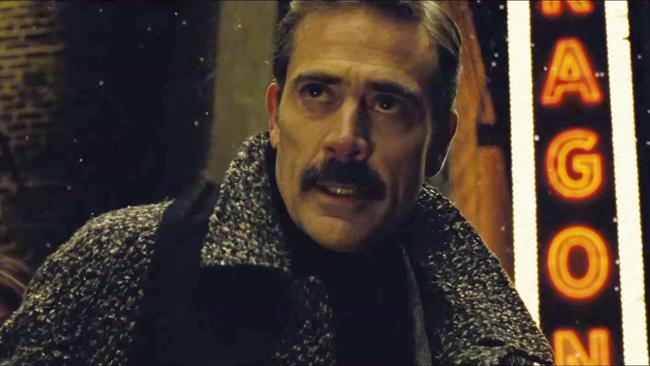
It's important to note that this may be the first film version of the Waynes to put more emphasis on Martha Wayne than Thomas Wayne. Not only is her name part of the plot, but in Bruce's nightmare, his attention focuses on Martha's side of the tomb rather than Thomas's.
Amazon Echo did a promotional game for the film, allowing fans to play to solve the mystery. Lo and behold the murderer turned out to be...Joe Chill again.
It's unknown whether Gotham or the DC film universe will further explore the murder of Thomas and Martha Wayne. Perhaps the Ben Affleck Batman has already confronted Joe Chill. Or perhaps he never found him.
Regardless, the murders of the Waynes, the man behind the trigger, and the fate of their killer has been constantly evolving since the beginning and will continue through the comics and adaptations for years to come.
comments powered by Disqus













by Silver Nemesis
by The Dark Knight
by Slash Man
by Slash Man
by The Joker
by Slash Man
by Gotham Knight
by Silver Nemesis
by The Joker
by The Dark Knight